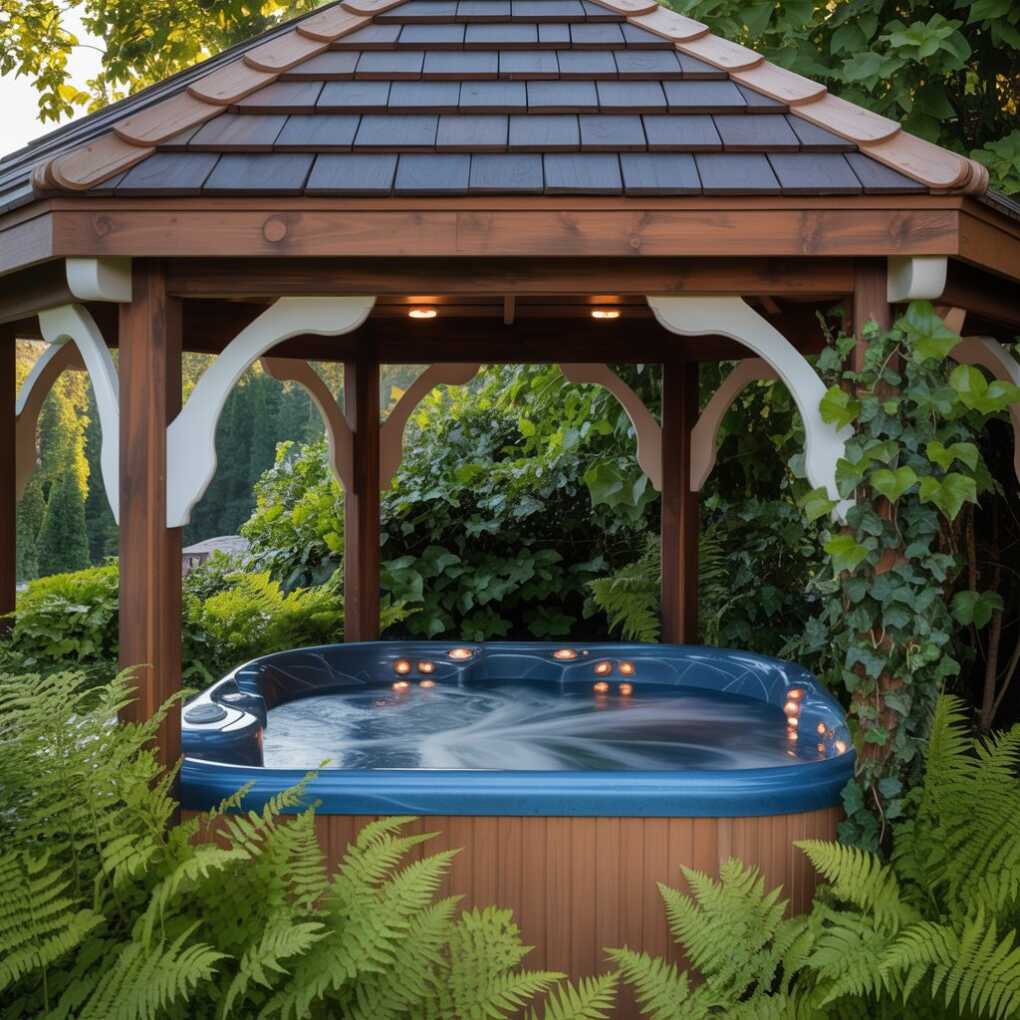Imagine stepping out onto your deck on a crisp evening, sinking into the warm bubbles of your hot tub, surrounded by a structure that shields you from prying eyes and unpredictable weather. A custom hot tub gazebo can turn this vision into reality, elevating your outdoor space into a private oasis. Whether you’re opting for an enclosed gazebo to keep out the elements entirely or something more open-air, these additions blend functionality with style. They not only protect your hot tub but also enhance the overall flow of your deck, making it a year-round retreat for relaxation and gatherings.
In this article, we’ll explore how a custom hot tub gazebo can redefine your deck. From design ideas to practical tips on installation and maintenance, you’ll get a comprehensive guide to making informed choices. We’ll cover everything from selecting materials to integrating smart features, all while keeping things grounded in real-world advice. By the end, you’ll have the insights needed to create a space that’s as practical as it is inviting.

Why Add a Hot Tub Gazebo to Your Deck?
Adding a gazebo over your hot tub isn’t just about aesthetics—it’s a smart way to maximize your investment in outdoor living. Hot tubs are fantastic for unwinding after a long day, but without proper coverage, they can become underused during bad weather or feel too exposed in a suburban backyard. A gazebo addresses these issues head-on, creating a dedicated zone that feels like an extension of your home.
One of the biggest draws is protection from the elements. Rain, snow, or harsh sun can degrade your hot tub over time, leading to faded covers or water contamination from leaves and debris. A well-designed gazebo acts as a barrier, extending the lifespan of your tub and reducing cleaning efforts. Plus, it allows you to enjoy soaks even when the weather turns foul. Think about those winter nights where steam rises against a snowy backdrop—it’s magical, but only if you’re not freezing while getting in and out.
Privacy is another key factor. In neighborhoods where houses are close together, a gazebo provides seclusion without building full walls. You can incorporate screens, curtains, or even climbing vines for a natural screen. This setup turns your deck into a personal spa, away from curious neighbors or passing traffic. And let’s not forget the visual appeal: a gazebo can tie together mismatched outdoor elements, like patio furniture or garden beds, into a cohesive look.
Beyond the basics, gazebos encourage more frequent use of your deck. Families often find that adding this structure turns the area into a social hub. Host barbecues where guests can dip in the tub, or use it as a quiet spot for morning coffee. Studies from home improvement experts show that such upgrades can boost property value by up to 10-15%, especially in regions with variable climates. It’s not just an add-on; it’s an investment in lifestyle enhancement.
Exploring Design Options for Your Gazebo
When it comes to designing a custom hot tub gazebo, the possibilities are vast, allowing you to tailor it to your deck’s size, your home’s architecture, and your personal taste. Start by considering the overall style—do you want something traditional with ornate details, or a sleek modern design that emphasizes clean lines?
Materials play a crucial role here. Wood, like cedar or redwood, offers a warm, natural feel that’s perfect for rustic decks. It’s durable against rot if treated properly, but it does require occasional staining. Metal options, such as aluminum or steel, provide a contemporary edge and stand up well to wind and rain with minimal upkeep. For those seeking low-maintenance alternatives, composite materials mimic wood’s appearance without the hassle of weathering or insects. These synthetics are engineered for longevity, often coming with warranties that span decades.
Shape and size should match your hot tub’s dimensions. Square or rectangular gazebos are straightforward and fit most standard tubs, while octagonal or hexagonal designs add a touch of elegance. Measure your deck carefully—ensure there’s enough space around the tub for easy access and maintenance. A good rule of thumb is to allow at least 2-3 feet on all sides for walking and any electrical hookups.
For added versatility, consider adjustable features. A louvered pergola style, for instance, lets you control sunlight and ventilation with rotating slats. This is ideal for decks in sunny areas, where you might want full shade during midday but open skies at dusk. Pergolas differ from full gazebos by being more open, but they can still support climbing plants or string lights for ambiance.
Don’t overlook roof styles either. A pitched roof sheds water and snow effectively, while a flat one might suit minimalist designs. Some gazebos even incorporate skylights or transparent panels to let in natural light without compromising coverage. Ultimately, the design should complement your deck’s existing features, like railings or steps, to create a seamless transition.
Customization Features to Enhance Functionality
Customization is where a hot tub gazebo truly shines, turning a basic structure into a personalized haven. Think beyond the frame—incorporate elements that cater to your daily routines and entertainment needs.
Lighting is a must for evening use. LED strips under the eaves or recessed fixtures in the ceiling provide soft illumination without harsh glare. Solar-powered options are eco-friendly and easy to install, charging during the day for nighttime glow. For a spa-like vibe, add color-changing lights that sync with music or apps.
Screens and enclosures add layers of comfort. Mesh screens keep bugs at bay during summer evenings, while retractable shades offer on-demand privacy. In colder climates, consider adding heaters or infrared panels to extend usability into fall and winter. Some setups include built-in benches or storage for towels and accessories, keeping everything organized.
Audio and tech integrations are increasingly popular. Waterproof speakers mounted in the gazebo allow for podcasts or playlists while you soak. Smart controls let you adjust lighting, temperature, or even the tub’s jets via your phone. If your deck is near the house, integrate the gazebo’s wiring with your home’s system for seamless power.
Aesthetic touches can make it feel unique:
- Plant integrations: Hooks for hanging baskets or trellises for vines soften the structure.
- Color schemes: Paint or stain to match your home’s exterior for harmony.
- Flooring upgrades: Non-slip mats or composite decking under the gazebo for safety.
- Seating areas: Built-in lounges around the tub for group hangs.
These features not only boost enjoyment but also adapt to changing needs, like family growth or seasonal shifts.
The Installation Process: Step by Step
Installing a custom hot tub gazebo might seem daunting, but breaking it down makes it manageable. Whether you’re handy with tools or prefer professional help, understanding the steps ensures a smooth outcome.
First, assess your deck’s foundation. It needs to support the added weight of the gazebo, tub, and water—often several thousand pounds. Reinforce joists if necessary, and check local building codes for permits. In some areas, structures over a certain size require inspections.
Gather materials and tools: Pre-fabricated kits simplify things with pre-cut pieces, while custom builds might involve more assembly. Basic tools include a drill, level, hammer, and measuring tape. For electrical work, like outlets for the tub, hire a licensed electrician to avoid hazards.
The process typically unfolds like this:
- Site preparation: Clear the deck area, mark the gazebo’s footprint, and level the surface.
- Foundation setup: Anchor posts into the deck using brackets or bolts for stability.
- Frame assembly: Build the base, then erect walls or supports, followed by the roof.
- Finishing touches: Install screens, lights, and any custom features.
- Final checks: Ensure everything is secure, test electricals, and seal joints against weather.
DIY enthusiasts can complete a basic install in a weekend, but larger or complex designs might take longer. If you’re not confident, professionals can handle it in a day or two, often including delivery. Costs vary, but expect to budget for labor if going that route.
Common pitfalls to avoid: Skipping the level check can lead to wobbly structures, and ignoring wind ratings in stormy areas might cause damage. Always prioritize safety—use sturdy ladders and wear protective gear.
Maintenance Tips for Longevity
A well-maintained gazebo keeps your deck looking sharp and your hot tub protected for years. Routine care prevents small issues from becoming big problems, saving time and money.
Start with regular inspections. Check for loose screws or bolts quarterly, tightening as needed. Look for signs of wear, like cracking in wood or rust on metal, and address them promptly. Cleaning is straightforward: Hose down surfaces monthly, using mild soap for stubborn dirt. Avoid harsh chemicals that could damage finishes.
For wooden gazebos:
- Apply sealant every 1-2 years to repel moisture.
- Watch for pests; treat with eco-friendly repellents if needed.
Composite materials are easier—wipe them down and forget about staining. Roofs require clearing debris to prevent clogs, especially after storms. In snowy regions, gently remove accumulations to avoid collapse.
Hot tub integration means coordinating maintenance. Ensure the gazebo’s cover doesn’t trap humidity, which can lead to mold. Ventilate regularly, and use dehumidifiers if enclosed. Seasonal prep, like winterizing pipes, extends everything’s life.
With consistent care, your gazebo could last 20-30 years, outlasting trends and providing enduring value.
Integrating Your Gazebo with the Deck Layout
Seamless integration turns a gazebo into a natural part of your deck, rather than an awkward addition. Consider traffic flow—position it for easy access from the house, avoiding bottlenecks.
Match materials for unity: If your deck is wood, echo that in the gazebo. Add pathways or steps if the tub sits at a different level. Landscaping enhances this—surround with plants or gravel for a bordered effect.
Lighting ties it together: Path lights from house to gazebo guide nighttime walks. Furniture placement matters too; arrange chairs around the tub for conversation zones.
In smaller decks, opt for compact designs to avoid overcrowding. Multi-level decks benefit from gazebos on upper tiers for views. Think about sun patterns—south-facing spots get more light, ideal for solar features.
Overall, integration boosts usability, making your deck a go-to spot for relaxation.
Budgeting and Cost Considerations
Planning a budget for a custom hot tub gazebo involves weighing initial costs against long-term benefits. Entry-level kits start around $2,000-$5,000, while custom builds can reach $10,000-$20,000 or more, depending on size and features.
Break it down:
- Materials: 40-60% of costs; composites are pricier upfront but save on maintenance.
- Labor: $1,000-$3,000 for pros; DIY cuts this.
- Extras: Lighting, screens add $500-$2,000.
- Permits and delivery: Factor in $200-$1,000.
Shop around for deals, and consider financing options for larger projects. Energy-efficient features, like insulated roofs, reduce utility bills over time. ROI comes from increased home value and personal enjoyment—many recoup 50-70% upon resale.
Prioritize must-haves: Protection and durability over bells and whistles if budget’s tight.
Bringing It All Together: Your Dream Deck Awaits
Transforming your deck with a custom hot tub gazebo opens up endless possibilities for outdoor living. From shielding against weather to adding stylish flair, it’s a upgrade that pays dividends in comfort and appeal. By choosing thoughtful designs, incorporating smart customizations, and maintaining diligently, you’ll create a space that’s uniquely yours.
Whether you’re soaking solo or hosting friends, this addition fosters memorable moments. Take the time to plan, and your deck will become the heart of your home’s exterior. Ready to start? Sketch your ideas, measure up, and dive into the process—your perfect retreat is just a build away.
